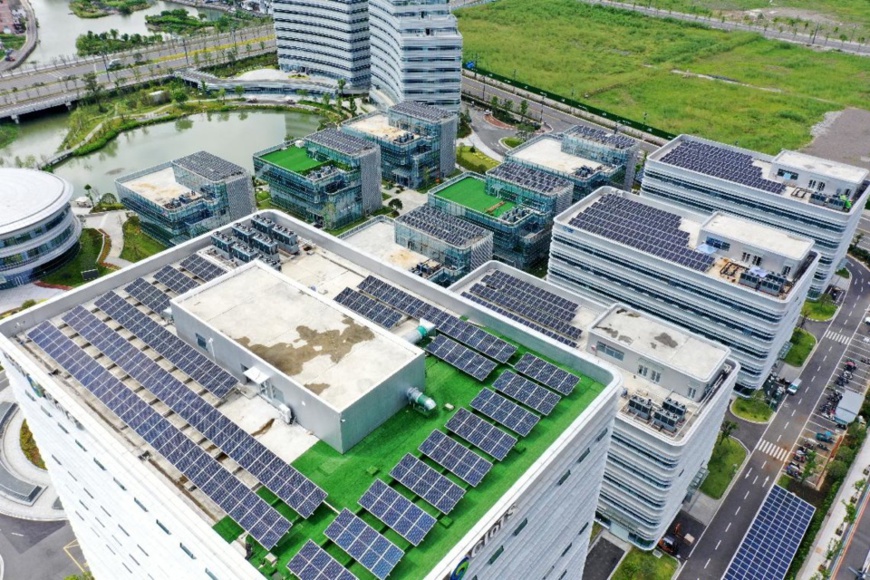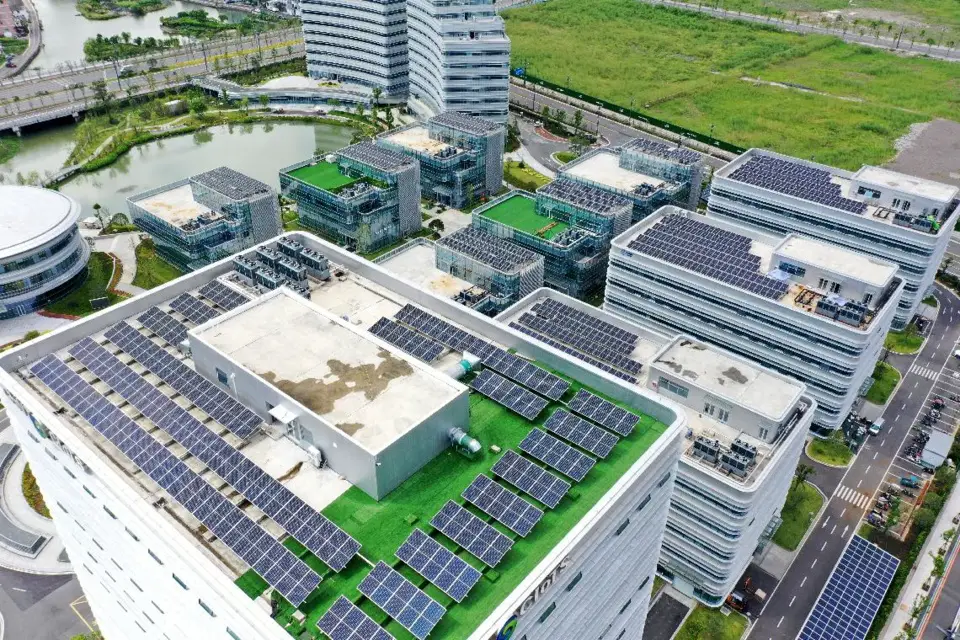By Jiang Nan, People’s Daily

Aerial photo taken on Sept. 7, 2021 shows distributed photovoltaic panels installed on the rooftops of CHINT IoT and Sensors Industrial Park in Yueqing, Wenzhou city, east China’s Zhejiang province. (Photo by Cai Kuanyuan/People’s Daily Online)
China is making great efforts to coordinate development and carbon emission reduction and balance economic growth and environmental protection, trying to turn the tremendous challenges of promoting green and low-carbon development into opportunities by fully leveraging sci-tech innovation, a key variable in the rapidly changing world.
The country is faced with a tight schedule, heavy tasks, and great pressure in promoting the transition to green and low-carbon development as it aims to peak carbon dioxide emissions before 2030 and achieve carbon neutrality before 2060, which means that it only has 30 years to move from peaking carbon dioxide emissions to achieving carbon neutrality, much less than the time developed countries took to reach the goal.
Since east China’s Zhejiang province doesn’t have much of an advantage of such energy resources as sunshine duration, some enterprises in the province have taken the lead in exploring innovative development models including photovoltaic (PV) agriculture project, fish-light complementary PV power generation project, project allowing multiple energy sources to complement each other, industrial and commercial rooftop PV project, household PV project, as well as integrated energy services.
The PV power generation project built in the shoals of Yueqing, Wenzhou city, Zhejiang province, by CHINT, a smart energy solutions provider in China, not only produces 180 million kWh of electricity a year, which is equivalent to reducing carbon dioxide emissions by 134,000 tons per year, but has also achieved success in planting sea rice under PV panels and in saline-alkali soil and growing agricultural products like wild rice shoot and lotus root on a trial basis.
With an average annual power generation capacity of nearly 400,000 kWh, a rooftop PV power generation system of the company can save more than 270,000 yuan ($41,850) in electricity costs for CHINT IoT and Sensors Industrial Park in Yueqing.
A smart energy management cloud platform, another example of new application scenarios of science and technology in the industrial park, helps monitor energy equipment and energy consumption in real time and makes power grid smarter and electricity more valuable through the use of big data, artificial intelligence (AI), and other technologies.
As an industry insider pointed out, new energy resources are bringing to the world unexpected changes driven by continuous sci-tech innovation.
As direct participants of market activities, enterprises have gained keen insight into market demand. At the 2nd International Industrial and Energy Internet Innovation and Development Conference held in Wenzhou in July this year, carbon peak and carbon neutrality became hot topics that attracted great attention from attendees at the conference.
In fact, more and more companies have reaped fruits and found business opportunities in promoting green and smart manufacturing, as well as industrial digitalization.
Through launching programs to remodel the traditional manufacturing industry and facilitate industrial digitalization, as well as other endeavors, Wenzhou has further integrated AI into its manufacturing industry and gathered a good number of outstanding enterprises and major projects in emerging industries including PV, wind power, and energy storage.
Facts have proven that by intensifying efforts to stimulate the endogenous power of enterprises for sci-tech innovation and help them truly grow into capable innovators, cities can better promote breakthroughs in key technologies concerning green and low-carbon development and advance the transition of production modes for energy conservation and carbon reduction.
China’s carbon peak and carbon neutrality goals signify profound changes in the patterns of both development and governance. In the process of realizing the goals, governments at various levels across the country have also brought into full play their roles in guiding and boosting market activities. By innovating systems and ensuring policy support and improving incentive, guidance, supervision and evaluation mechanisms, they have effectively driven green, low-carbon, and high-quality development.
The government of Yueqing, for instance, has offered more favorable and differentiated policies in such aspects as finance, taxation, and the use of land to enterprises that have performed well in energy conservation and carbon reduction based on their “energy bills” including energy consumption per unit of value added, carbon emissions per unit of output value, and the proportion of clean energy in their energy mix.
In this way, the city has guided and motivated enterprises to make innovations and tap their potential for digital transformation and low-carbon development.
As the country quickens its steps toward energy conservation and carbon emission reduction, a good number of strategic emerging industries will benefit from relevant endeavors and enjoy fast growth and the traditional manufacturing industry is also embracing huge development opportunities for its green and digital transformation, according to analysis.
By leveraging the key variable of sci-tech innovation well, seizing new opportunities, and creating new economic growth points, the country is expected to achieve the “maximum increment” in the pursuit of high-quality development.
The country is faced with a tight schedule, heavy tasks, and great pressure in promoting the transition to green and low-carbon development as it aims to peak carbon dioxide emissions before 2030 and achieve carbon neutrality before 2060, which means that it only has 30 years to move from peaking carbon dioxide emissions to achieving carbon neutrality, much less than the time developed countries took to reach the goal.
Since east China’s Zhejiang province doesn’t have much of an advantage of such energy resources as sunshine duration, some enterprises in the province have taken the lead in exploring innovative development models including photovoltaic (PV) agriculture project, fish-light complementary PV power generation project, project allowing multiple energy sources to complement each other, industrial and commercial rooftop PV project, household PV project, as well as integrated energy services.
The PV power generation project built in the shoals of Yueqing, Wenzhou city, Zhejiang province, by CHINT, a smart energy solutions provider in China, not only produces 180 million kWh of electricity a year, which is equivalent to reducing carbon dioxide emissions by 134,000 tons per year, but has also achieved success in planting sea rice under PV panels and in saline-alkali soil and growing agricultural products like wild rice shoot and lotus root on a trial basis.
With an average annual power generation capacity of nearly 400,000 kWh, a rooftop PV power generation system of the company can save more than 270,000 yuan ($41,850) in electricity costs for CHINT IoT and Sensors Industrial Park in Yueqing.
A smart energy management cloud platform, another example of new application scenarios of science and technology in the industrial park, helps monitor energy equipment and energy consumption in real time and makes power grid smarter and electricity more valuable through the use of big data, artificial intelligence (AI), and other technologies.
As an industry insider pointed out, new energy resources are bringing to the world unexpected changes driven by continuous sci-tech innovation.
As direct participants of market activities, enterprises have gained keen insight into market demand. At the 2nd International Industrial and Energy Internet Innovation and Development Conference held in Wenzhou in July this year, carbon peak and carbon neutrality became hot topics that attracted great attention from attendees at the conference.
In fact, more and more companies have reaped fruits and found business opportunities in promoting green and smart manufacturing, as well as industrial digitalization.
Through launching programs to remodel the traditional manufacturing industry and facilitate industrial digitalization, as well as other endeavors, Wenzhou has further integrated AI into its manufacturing industry and gathered a good number of outstanding enterprises and major projects in emerging industries including PV, wind power, and energy storage.
Facts have proven that by intensifying efforts to stimulate the endogenous power of enterprises for sci-tech innovation and help them truly grow into capable innovators, cities can better promote breakthroughs in key technologies concerning green and low-carbon development and advance the transition of production modes for energy conservation and carbon reduction.
China’s carbon peak and carbon neutrality goals signify profound changes in the patterns of both development and governance. In the process of realizing the goals, governments at various levels across the country have also brought into full play their roles in guiding and boosting market activities. By innovating systems and ensuring policy support and improving incentive, guidance, supervision and evaluation mechanisms, they have effectively driven green, low-carbon, and high-quality development.
The government of Yueqing, for instance, has offered more favorable and differentiated policies in such aspects as finance, taxation, and the use of land to enterprises that have performed well in energy conservation and carbon reduction based on their “energy bills” including energy consumption per unit of value added, carbon emissions per unit of output value, and the proportion of clean energy in their energy mix.
In this way, the city has guided and motivated enterprises to make innovations and tap their potential for digital transformation and low-carbon development.
As the country quickens its steps toward energy conservation and carbon emission reduction, a good number of strategic emerging industries will benefit from relevant endeavors and enjoy fast growth and the traditional manufacturing industry is also embracing huge development opportunities for its green and digital transformation, according to analysis.
By leveraging the key variable of sci-tech innovation well, seizing new opportunities, and creating new economic growth points, the country is expected to achieve the “maximum increment” in the pursuit of high-quality development.
 Menu
Menu
 China speeds up green, low-carbon development with sci-tech innovation
China speeds up green, low-carbon development with sci-tech innovation
















